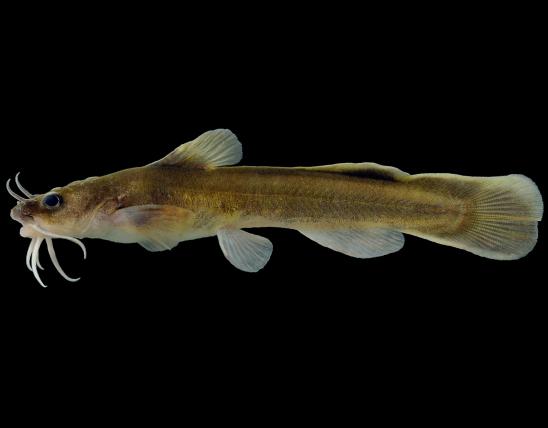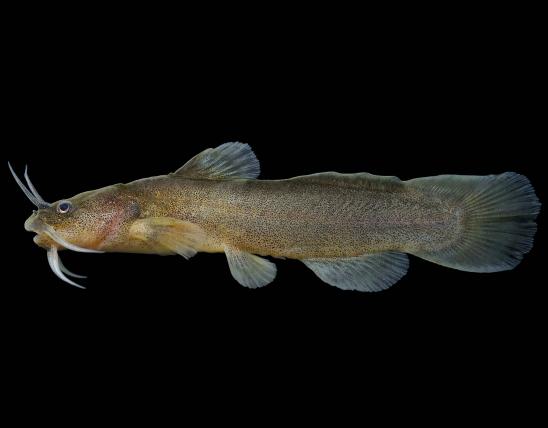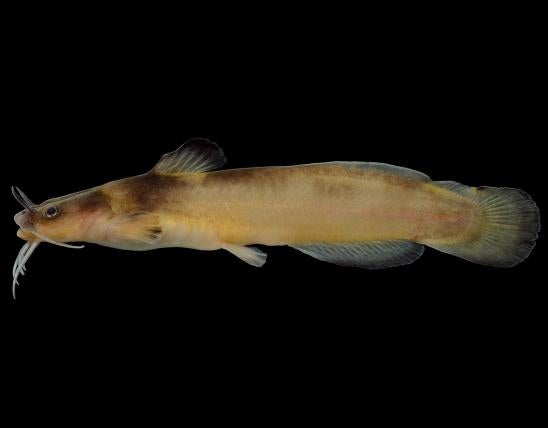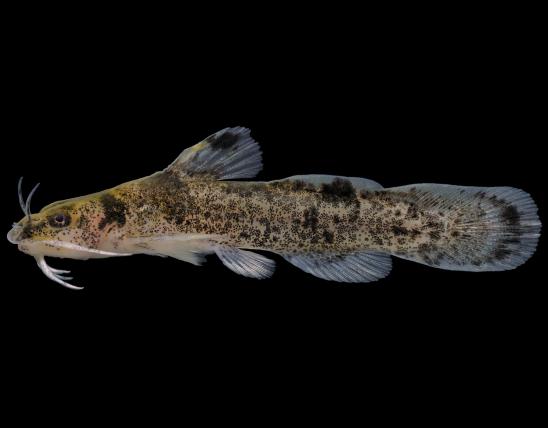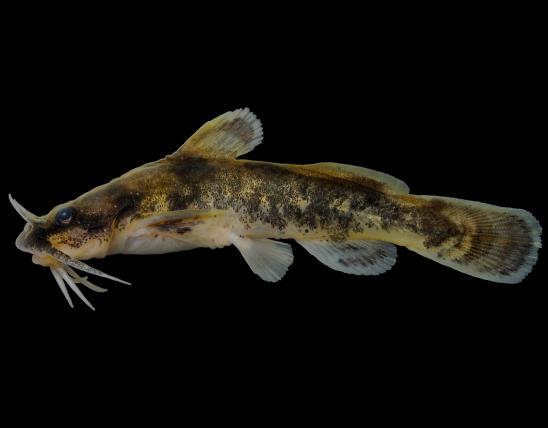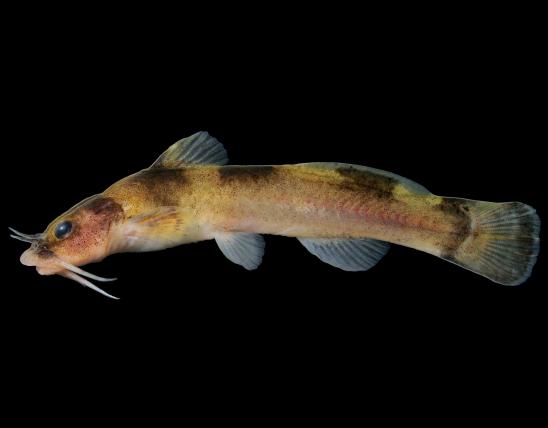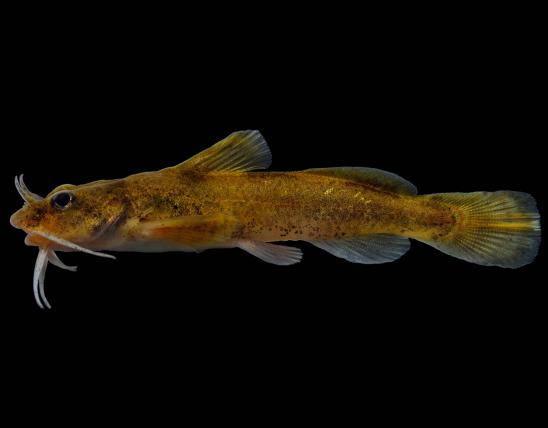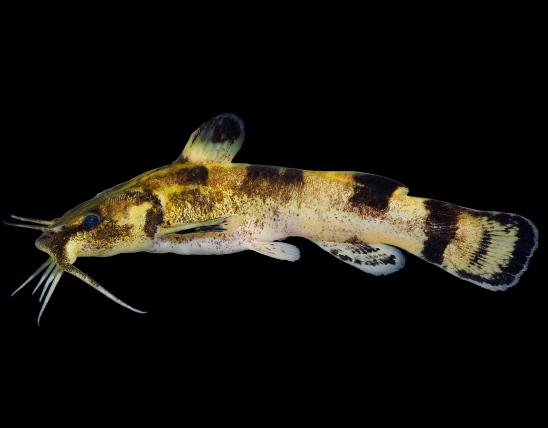
The tadpole madtom occurs in Missouri’s southeastern lowlands and in a broad zone from southwest Missouri to northeast Missouri. This small, chubby catfish is the most abundant madtom in the Bootheel lowlands and is common in northeastern Missouri.
Madtoms, as a group, are small, secretive catfishes that most people never see. The key identifier for madtoms has to do with the adipose fin (the small, fleshy fin that is present on the midline of the back just ahead of the tail fin). In madtoms, the adipose fin forms a low, keel-like ridge without a free, flaplike lobe along the trailing edge. The adipose may be connected to the tail fin, or it may have (at most) a slight notch in between. (In our other catfishes, the adipose fin forms a free, flaplike lobe, widely separate from the tail fin.)
The tadpole madtom can be distinguished from Missouri’s other madtoms by the following:
- The pectoral spine lacks sawlike teeth on the rear margin.
- The upper jaw does not project beyond the lower jaw (the two jaws are nearly equal).
- The underside of the head and body are not sprinkled with dark speckles.
- The midside usually has a prominent veinlike dark line that is not normally present in other madtoms.
- The body and fins are otherwise plain, without definite dark blotches, bars, and speckles.
- The tooth pad on the upper jaw lacks backward extensions.
- The notch between the adipose fin and the tail fin is closer to the dorsal fin base than to the tip of the tail fin.
The back and sides are uniformly light tan or chocolate brown with a narrow dark line along the midside. The belly is pale white or pale yellow. The fins are similar in color to the adjoining parts of the body.
Most madtoms possess a mild venom that is associated with the pectoral and dorsal spines. When introduced into a puncture wound produced by the spine, the venom causes a painful reaction. The spines are often erected and locked in place when the madtom is alarmed, increasing the chance of a puncture. The venom is not considered dangerous to people, and the chances of being “spined” are not great if the possibility is kept in mind when handling a madtom. If you’ve been jabbed by a madtom spine and think you’re having a severe reaction, seek medical attention.
Similar species: Missouri has three other madtoms whose bodies are rather uniformly colored and lack distinct dark blotches, bars, or saddle marks: The stonecat and the freckled madtom, and the slender madtom. The stonecat and the freckled madtom (N. flavus and N. nocturnus) both have an “overbite,” with the upper jaw overhanging the lower jaw instead of the two jaws being nearly equal. The slender madtom (N. exilis) shares with the tadpole madtom the “equal” jaw length, but its anal, tail, and dorsal fins are dark-edged, and its pectoral fin spine has well-developed teeth on the back margin. It’s also a slenderer fish (not chubby like the tadpole madtom).
There are about 30 species of madtoms (in the genus Noturus), and all occur in the central and eastern United States and nearby parts of Canada. In Missouri, 10 species of madtoms have been recorded. It can be difficult to separate the different species of madtoms using the traditional methods of fish ID (counting fin rays, for instance, or comparing ratios of body-part measurements). Noting differences in pigmentation (such as dark bars or patches) can help, but such coloration often varies by particular locality and habitat (such as amount of vegetation, turbidity, or different substrates). Color can also vary by a fish’s health, mood, breeding condition, sex, and individual genetics, and dead fish may show little coloration at all. Molecular (DNA) date is being used more and more as a way to separate the species; of course, it is not very useful in the field. Geography can be a good clue for species IDs, since different species may be restricted to certain stream systems and never occur in others.
Habitat and Conservation
The tadpole madtom occurs throughout the Bootheel lowlands and in a broad zone extending from the Spring River in southwest Missouri into the tributaries — creeks and backwaters — of the Missouri River in central Missouri and of the Mississippi River in northeastern Missouri.
It is the most abundant madtom in the Bootheel lowlands, and it is common in northeastern Missouri. It occurs only peripherally in the Ozarks, and it is absent from most of the prairie region of northwest Missouri.
It inhabits clear to moderately turbid waters having little current. It requires an abundance of cover, thick growths of submergent plants or accumulations of leaves, sticks, and other organic debris. In the Bootheel lowlands, it is abundant in ditches having thick growths of submerged aquatic plants and along the margins or the swifter ditches in beds of water willow (Justicia) or deposits of detritus. In the prairie region of northeast Missouri, it inhabits quiet pools of sluggish creeks draining level uplands and backwaters and overflow pools along the larger rivers.
Like all madtoms, this fish is secretive, spending daylight hours lurking about heavy cover. It comes out at night to forage for food.
Food
Life Cycle
Human Connections
Although madtoms are not useful to people as food or game, they are interesting animals that contribute to the diversity and health of the aquatic ecosystems they inhabit.
Madtoms are eaten by larger fish, including smallmouth bass, walleye, and trout. Some anglers collect them for bait.
These diminutive catfish can inflict a painful puncture wound with the spines on their pectoral and dorsal fins. Like all of Missouri’s catfish species, madtoms have venom glands at the base of these fins. The glands secrete venom that becomes incorporated in the slime and cells that make up the spine. Because madtoms are so small, it's difficult to avoid their tiny, sharp spines, especially if you are trying to impale them on a fishing hook. Many describe the pain that comes from being “horned” by a madtom as similar to a bee sting. Others claim it to be much worse. It’s best to handle madtoms carefully.
Ecosystem Connections
We all know the story about the “big fish” eating the “little fish.” Madtoms are rather small, compared to other catfishes, and as such are more vulnerable to predation throughout their lives. The mildly venomous spines of the madtoms are one adaptation that helps them avoid being eaten.
Madtoms are part of the complex web of feeding relationships that occur in streams. Though small, madtoms are often abundant in streams, and their populations represent a significant link in the food chain.
























